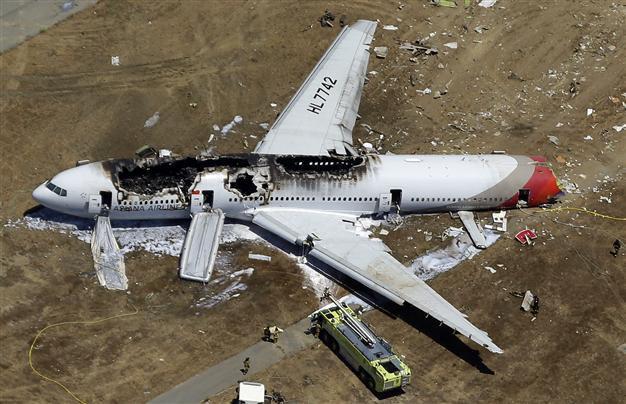Pilot told passengers to stay in seats after US crash
LOS ANGELES - Agence France-Presse

In this Saturday, July 6, 2013 aerial photo, the wreckage of Asiana Flight 214 lies on the ground after it crashed at the San Francisco International Airport, in San Francisco. AP photo
According to air safety officials, the pilot of the Asiana Boeing 777 which crashed in San Francisco told attendants not to begin evacuating passengers in the chaotic immediate aftermath of the accident.
The pilot has also reported being blinded by a flash of light upon approach as the plane came in low, but the source of the light and its role in the crash are not known, said Deborah Hersman, head of the National Transportation Safety Board (NTSB).
She said cabin crew had sought guidance from the cockpit after Saturday's crash, which left two people dead and more than 180 injured.
Pilots initially told flight attendants not to initiate evacuation procedures, Hersman said.
It was only after cabin staff alerted the cockpit to flames spreading outside the plane that the order was given to begin evacuation.
"We don't know what the pilots were thinking, though I can tell you in previous accidents there have been crews that don't evacuate, they wait for other vehicles to come to be able to get the passengers out safely," Hersman said.
Hersman suggested that pilots in the cockpit may not have been in a position to spot the fire outside the plane.
She emphasized that once flames were sighted, the evacuation began swiftly -- approximately 90 seconds after impact.
"Certainly, if there is an awareness that there's fire on board an aircraft, that is a very serious issue ..." Hersman said.
"The pilots are in the front of the airplane, they really don't have a good sense of what's going on behind them, they need to get that information from the flight attendants, but we will certainly be looking into that issue. "Hindsight is 20-20. We all have a perspective that's different than some of the people who are involved in this. "We need to understand what they were thinking, what information they had, what their procedures are, if they complied with those procedures and if that evacuation took place in a timely manner." Pilot Lee Kang-Kuk also told authorities in Seoul and US investigators that he was blinded temporarily by a flash of light when the plane was at an altitude of about 500 feet as it approached the runway.
"We need to understand exactly what that is, identify if there are any sources of light," Hersman said.
"He did talk to us about the approach and landing. He relayed that to us but it was a temporary issue," Hersman said.
Emergency response vehicles arrived on the scene approximately two minutes after the crash and began extinguishing flames three minutes after impact.
Hersman said interviews with the plane's crew had given investigators a vivid portrait of the scene on board the stricken aircraft moments after the crash.
Two emergency slides had inflated inwards inside the cabin, pinning two attendants who needed to be cut free as the evacuation began.
It was not immediately known why the slides had deployed inside the aircraft.
Flight 214 crashed when it clipped a seawall short of the runway, skidding out of control, shredding the tail of the plane and catching fire.
The NTSB has already determined that the plane was traveling well below the target speed necessary for landing.
It has also emerged that the otherwise experienced pilot of the plane, 46-year-old Lee, was undergoing his first major training on the Boeing 777.
